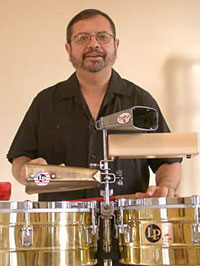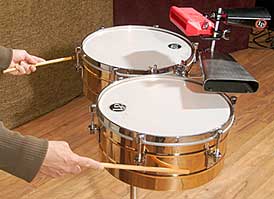"A good drummer listens as much as he plays." ~ Indian Proverb
Percussion Store Drummers Drum Lessons Drumming FAQs
International Shipping
"A good drummer listens as much as he plays." ~ Indian Proverb
Percussion Store Drummers Drum Lessons Drumming FAQs
International Shipping
![]()
![]()
Drums & Percussion
Drum Sets & Cymbals
Cymbals, Hardware & Accessories
Latin Percussion
LP Hardware, Accessories & Replacement Parts
Middle-East Drums & Percussion
African Drums & Accessories
Chinese & Eastern Drums & Percussion
Irish Drums & Percussion
Orchestra Bells & Chimes
Drum & Percussion Hardware
![]()

A lesson from
Victor Rendon's book
The Art of Playing Timbales
Often there is confusion as the definitions of certain terms in Latin music. This is particularly true when using the terms salsa, guaracha, mambo, son montuno, etc. For example, the term mambo can mean a dance style, a rhythm, a section of a tune, or a style trait such as the mambos of Perez Prado, as opposed to a mambo played by Tito Puente. Rather than try to define each style, I have grouped them under the heading of “son.” (Son is perhaps the oldest and certainly the classic Afro-Cuban form, an almost perfect balance of African and Hispanic elements.)
These dance styles are felt in a pulse of “2” or duple feel, in contrast to a straight 4/4 feel as in the cha cha chá. The guaracha and mambo are generally played faster than a son montuno and have a more aggressive quality. However, they can all use the same rhythm pattern and variations. The way to differentiate these style characteristics is by listening to the music. A list of recommended listening is included at the end of this section.
The paila sound (playing on the sides of the shell) is usually used when the singer is singing the lyrics. When the tune reaches the chorus or montuno section, the timbale and bongo player go to their bell. The paila is played with the right hand on the shell while the left hand plays a muffled tone on beat two and an open tone on beat four.
Diagram A shows the most common paila pattern used today. The left hand plays a muffled tone on beat 2, and open tone on beat 4. For variations of theses rhythms, please refer to Diagram B.
The paila can also be played with both sticks on the shells. This is sometimes called double paila. The right hand stick is played on the outer side of the right shell. The left hand stick is played on the outer side of the left shell. If you compare the previous patterns with the following, you will notice that the right hand is still playing the same rhythm while the left hand is filling in the holes to make it into a continuous 8th-note pattern.
 Diagram
C is notation for the next two patterns which make use of the accents with
the right-hand.
Diagram
C is notation for the next two patterns which make use of the accents with
the right-hand.
The conga tumbao is the same as the cha cha cha but played faster. As a general rule, stay on one drum while the timbale players plays paila. Please refer to Diagram D.
The straight eighth-note pattern on bongos is called martillo. Variations or riffs, sometimes call repiques are played according to the music. Repiques are played in clave. Please refer to Diagram E. for the notation that shows ten common repiques played bongoceros.
Diagram F is the percussion score for the basic son rhythms learned so far; paila on timbales, martillo pattern on bongos, and basic tumbao on congas. Study how the parts interact and be able to play each pattern/instrument.
When the band goes to the montuno section, the timbale and bongo player go to the bell. At this point, the conga player goes to two drums. Diagram G shows the most common patterns used in the montuno section.
Recommended Listening: Tito Puente, Machito, Félix Chapotín, Ray Barretto, Mario Bauza, Willie Colón, Benny Moré, Eddie Palmieri, Charlie Palmieri, Pérez Prado, Arsenio Rodríguez, Willie Rosario, Poncho Sanchez, Larry Harlow, Joe Cuba, Típica 73, El Gran Combo, Los Kimbos, Conjunto Libre
Standard Tunes: Bilongo, Se Acabo La Malanga, Ran Kan Kan, Picadillo, El Manicero, Son De La Loma, Maria Cervantes, Sabor, Mamblues, Alonzo, Mambo Inn, Manteca
For further information regarding The Art of Playing Timbales, go to: www.minifilms.com
Timbales for Sale
Drum Lessons